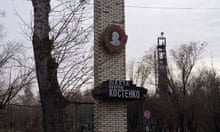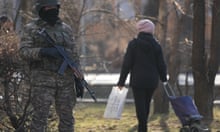“Do you know why women in Astana don’t get expensive haircuts?” asked television presenter Dinara Tursunova. “Because no sooner do you leave the beauty salon, the wind blows away your hairdo, and with it all the money you spent.”
Looking good in the capital city of Kazakhstan is hard work. When Tursunova moved to Astana three years ago for a job with a local broadcaster, what first struck her was the cold and the wind. “In winter I go around the city in skiing outfits and fur-lined sneakers. It probably wouldn’t hurt to put spikes on my shoes. When the wind starts whipping up, you will see people on the ice literally flying away,” she says.
Astana is a relatively new capital. President Nursultan Nazarbayev decreed in late 1997 that Almaty, a leafy city leaning against a spur of the Tien Shan mountains, was no longer up to the job. Even he had to concede, however, that the forbidding, featureless expanse of steppes in which Astana was to be built posed formidable challenges for comfortable living.
Winter proper typically begins in November and the city only sees some semblance of warmth around May. Temperatures in winter tend to hover around -20C. In the chilly world capital stakes, Astana is pipped to the post only by Ulaanbaatar in Mongolia.
At Nazarbayev’s behest, city authorities embarked in 1997 on a project to plant a million-tree ring that believed would go some way toward taking the edge off the icy winds. Twenty years on, the mega-green ring is still being planted.
Astana and its environs are no stranger to attempts at utopian landscape-crafting. In the early 1960s, when Kazakhstan was still part of the Soviet Union, the city was renamed from Akmolinsk to Tselinograd in recognition of its role as a capital of Communist leader Nikita Khrushchev’s abortive Virgin Lands Campaign (tselina, meaning virgin soil), which was intended to turn once-barren steppes into bountiful breadbaskets. In 1992, that experiment now only a memory, the town’s name reverted to Akmola (Kazakh for “white grave”). It would later again be renamed Astana – simply “capital city”.
The city has struggled from the outset with a failure to consider solutions that take the severity of the climate into account.

“Developers weren’t particularly interested in that,” explains Astana-based designer and architect Diana Hegai. “Their goal was to design impressive-looking buildings, to build them fast and then sell them at a profit.”
Historians of the city suggest that the haste with which many buildings were erected was based in part on the belief that a post-Nazarbayev government might cool over the Astana project and restore the capital status of Almaty, around 600 miles to the south. A quarter of a century on, though, and it does not look like Nazarbayev plans to step aside any time soon.
The challenge for residential property developers arises in striking the right balance between the city’s overarching vision and coping with local climate conditions.
“We tried to understand which types of buildings have a more effective design with regards to wind comfort and safety,” says Serik Tokbolat, a researcher at Astana’s Nazarbayev University. “Box-shaped residential building complexes are preferable to free-standing buildings as they experience fewer vortexes around corners and create more comfortable conditions in courtyards.”
As a rule though, it is mostly the upscale apartment complexes that are built in those desirable, closed formations, protecting them from the wind. Services such as grocery stores, pharmacies and hairdressers are often incorporated in the buildings, reducing the need for residents to wander outside.
“Anybody obliged to navigate Astana on foot in winter is not to be envied,” says Vadim Ni, head of the Ecological Forum of Public Organisations of Kazakhstan.
Salt of the earth
After Nazarbayev’s 1997 declaration scientists were put to work studying just how receptive the soil around Astana would be to the creation of woods in a spot where no trees stood.
Very few trees survived the steppe conditions in the first few years. So the focus turned to planting trees in test conditions to evaluate in advance just how well they could withstand the climatic whims of Astana.
Weather is only part of the problem, they found. The high proportion of dissolved salts in the soil around the city means one crucial preliminary stage is to sow hardy, perennial grasses. That reduces the salinity of the earth and in turn attracts insects, enriching the ecosystem.
More recent attempts at forestation have seen the survival rate boosted to around 70%.
“Over the past 10 years, temperatures in the capital have increased by 0.3C. And thanks to the green belt, average wind speeds are down, and we have seen a threefold drop in the amount of snowstorms and fog,” says Gulmira Akisheva, the head of long-term forecasts at the Kazgidromet national meteorological centre.
Currently around 5,000 new trees, a mixture of coniferous and deciduous varieties, are planted every year at an annual cost of 2 billion tenge (£4.5m). The city’s green belt is projected to expand from 200,000 to 250,000 acres by 2020.
Tokbolat says the full potential will only be seen when the forests reach full size and maturity, but that the fringe benefits can already be felt. “The green belt zone is creating a habitat for animals and birds, as well as a potentially great space for the city’s population to spend their leisure time.”
This article was produced in collaboration with Eurasianet
Follow Guardian Cities on Twitter and Facebook to join the discussion










Comments (…)
Sign in or create your Guardian account to join the discussion